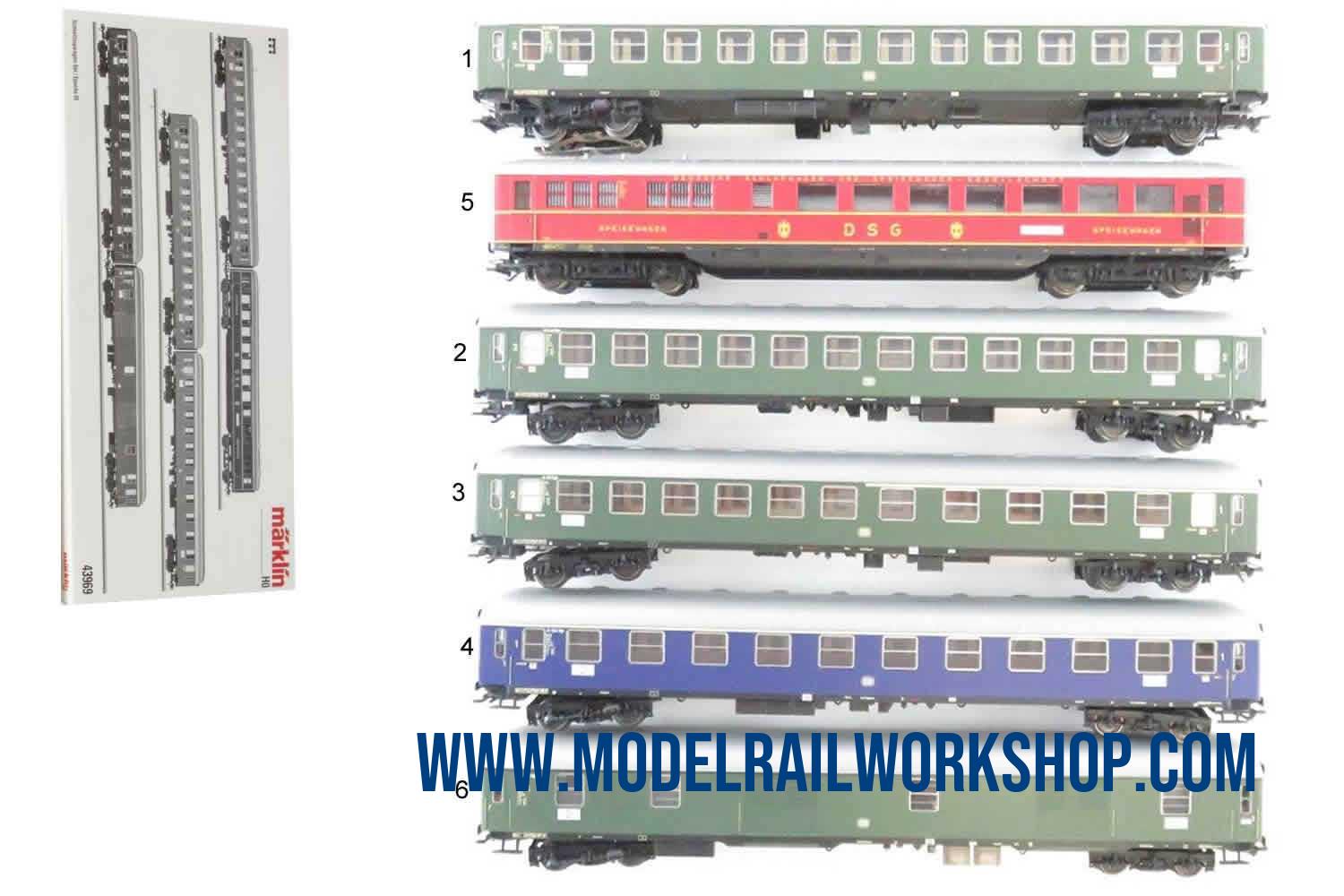| Express Train Passenger Car Set.
6 different German Federal Railroad (DB) express train passenger cars of different designs as express train D265 Basle SBB - via Wuppertal - Hagen, authentic for the route segment Cologne - Hagen. 1 type D4üm-60 baggage car, 1 type A4üm-61 compartment car, 1st class, 1 type AB4üm-63 compartment car, 1st/2nd class, 2 type B4üm-63 compartment cars, 2nd class, 1 type WR4ü(e)-39 dining car. The cars look as they did around 1963.
Source: www.maerklin.de
The development of passenger car construction almost completely interrupted by World War II and its effects in Germany, and passenger car development did not start up again until the end of the Forties with the planning and construction of 16 test cars. While the first of these test cars borrowed heavily in terms of design and basic form from the prewar designs, Wegmann of Kassel placed into service three new, 26.4 meter / 86 foot 7-5/16 inch long fast train coaches with center entrance doors. The basic design and the essential features of the technical equipment for these cars were largely adopted unchanged for the different series of around 750 such fast train coaches. They also formed par excellence the starting point for the postwar development in German passenger car construction that even developed into the UIC standard (UIC = Union Internationale des Chemins de fer = International Railroad Association). The new development in the construction of passenger cars was characterized primarily by the lengthening of the cars to a standard length of 26.4 meters / 86 feet 7-5/16 inches for all the car types. All of the new passenger cars were equipped with the Minden-Deutz design trucks with coil springs. The long, standard design length of the car also added to the design advantages of the trucks. This length resulted from the unusual pivot point distance of 19 meters / 62 feet 4 inches. Typical of the DBs 26.4 meter / 86 foot 7-5/16 inch long cars were the excellent running characteristics for the majority of the seats in the cars. This was achieved with simple running gear and was maintained over long periods of operation. In addition to the greater seat width, a claim could be made in general for a considerable increase in travel comfort in both car classes for long distance service. This was achieved with better lighting with fluorescent lamps, upholstered seats that could be pulled out for lying on, adjustable head cushions, reading lamps, additional rest rooms, as well as practical interior fittings that made it possible to keep the car interiors cleaner. The car bodies for all of the 26.4 meter / 86 foot 7-5/16 inch cars looked pretty much alike and were welded using lightweight rolled side sills so that the outer skin of the cars was an integral part of the load-bearing elements. After the first prototypes were also delivered for long distance service, regular production began in 1952 for different types of the new express train passenger cars. New UIC rules regarding rigidity required a modification of the car body from 1960 on so that the area of the car ends was made more collision resistant. This in turn necessitated a modified frame design. Instead of the previous four-part folding doors on the car ends, a two-part sliding door design that could be opened by hand was installed. The following quantities of the basic designs were purchased by the DB: 344 compartment cars, 1st class (A4üm), 718 compartment cars, 1st/2nd class (AB4üm), 3,180 compartment cars, 2nd class (B4üm), 182 baggage cars (D4üm), and 301 combined baggage and compartment cars, 2nd class (BD4üm). The 26.4 meter / 86 foot 7-5/16 inch cars garnered additional honors at the start of the first class Intercity network in 1971 and the expansion of the IC to include second class cars in 1979. There the use of these cars did not end until 2005. |
